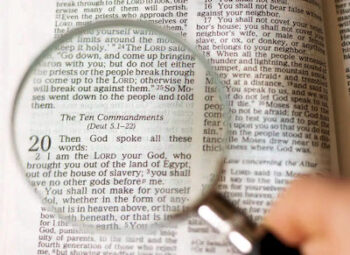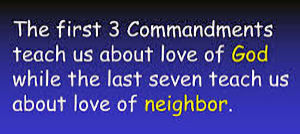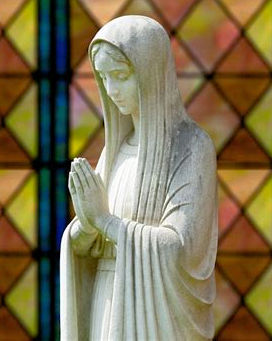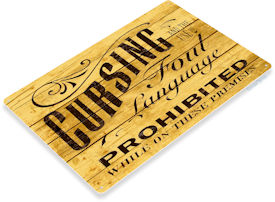Three months after leaving Egypt, the Israelites arrive at Mount Sinai in the desert and they camped there. By command, Moses goes up the mountain to speak with the LORD, (YHWH, Yahweh, Jehovah, Adonai, Elohim), who dictates demands for the people. The rules imparted makeup the Decalogue, a list of religious and moral laws by which they were to live.
God’s rules are better known as The Ten Commandments, although the words “ten” and “commandment” do not appear in the Bible chapter.1 These laws, as described in the original language, are literally called “utterances.”2
They prominently feature attributes of ethics and morality for Judaism, although many other religions have comparable laws or principles, such as Buddhism, Hinduism, and Jainism. Twice these lists of laws are found in the Hebrew text, at Exodus 20:3-17 and Deuteronomy 5:6-21.3 Making several trips up and down the mountain, Moses communicated with God over a period of forty days and was finally given two small stone tablets inscribed with the Law. The narrative of all that happened is primarily described in Exodus, chapters 19–24.
What is described is all relative to the fact that God singles out his people from all other nations to be his priests, “his pure, distinct, holy representatives.” It will now be the Israelites’ job to represent Yahweh to the nations and bring them to the one real Creator of everything. Therefore, God’s reputation will depend upon Israel’s example.4
The main event begins when God gets everyone’s attention and demonstrates his mighty power. As Yahweh descended on the mountain, there was an awesome display of special effects: smoke, fire, thunder, lightening, rumbling, shaking. Some commentators believe Mount Sinai was a volcano, but the traditional location of Mount Sinai — today’s ‘Gebel Mousa’, meaning Mount Moses — isn’t volcanic.5
 God then proceeds to give the first part of his law system, the Ten Commandments. In essence, they are a summary of the hundreds of laws which will be forthcoming in the scriptures. “Designed to guide Israel into a life of practical holiness, the Ten Commandments offer basic rules of behavior for spiritual and moral living.”6
God then proceeds to give the first part of his law system, the Ten Commandments. In essence, they are a summary of the hundreds of laws which will be forthcoming in the scriptures. “Designed to guide Israel into a life of practical holiness, the Ten Commandments offer basic rules of behavior for spiritual and moral living.”6
While the whole event of God’s personal visit makes for an interesting read, the focus of this article is only on the first three commandments given to his people. These first three laws are specific to how they were to relate to God, himself. And realizing that some few Christian denominations divide the commandments in different ways, I will use the text division as do the overwhelming majority of Christian churches. There are other OBS articles on other commandments and they are listed at the end of the article in References & Notes.7
The First Commandment
“You shall have no other gods before me” (Exodus 20:3, NRSV).8
The phrase “shall have no” means “don’t ever” and is used as would a superior being to an inferior one, but not the other way around. Israel’s laws were coming from God and could not be changed by the whim of the people.9 Although many commentators interpret this to be an assertion of a monotheistic doctrine, this verse never states that Yahweh is the only god or that other gods are delusions. What it does state, simply, is that there must be absolute loyalty only to Yahweh. Otherwise, it would constitute a direct insult.10
Some scholars believe that God wasn’t forcing people to give up the worship of other deities, but the commandment laid down a sort of heavenly hierarchy. Yahweh was at the top and was to be worshiped first, before other lessor gods. They suggest early Judaism did not deny the existence of other gods, but the Israelites were being directed toward monotheism little-by-little.11
 And some others believe a heavenly hierarchy is also indicated in the New Testament. Many non-Trinitarians postulate God is the father (primary God) and his son Jesus (second in command) are two individual entities. Their joint position would be considered as a single office of creation or power. When Jesus stated “The Father and I are one” (John 10:30), he was not saying he was the father, or that the father was he; he was saying they act and work as a single unit. Even so, Jesus always spoke of his father as the boss. “I do as the Father has commanded me,” (John 14:13). For a non-Trinitarian study, see “Can you be a Christian and Not Believe in the Trinity?” listed in References & Notes.12
And some others believe a heavenly hierarchy is also indicated in the New Testament. Many non-Trinitarians postulate God is the father (primary God) and his son Jesus (second in command) are two individual entities. Their joint position would be considered as a single office of creation or power. When Jesus stated “The Father and I are one” (John 10:30), he was not saying he was the father, or that the father was he; he was saying they act and work as a single unit. Even so, Jesus always spoke of his father as the boss. “I do as the Father has commanded me,” (John 14:13). For a non-Trinitarian study, see “Can you be a Christian and Not Believe in the Trinity?” listed in References & Notes.12
The Second Commandment
“You shall not make for yourself an idol, whether in the form of anything that is in heaven above, or that is on the earth beneath, or that is in the water under the earth. You shall not bow down to them or worship them; for I the LORD your God am a jealous God, punishing children for the iniquity of parents, to the third and the fourth generation of those who reject me, but showing steadfast love to the thousandth generation of those who love me and keep my commandments” (Exodus 20:4-6).
During God’s encounter with the Israelites at Mount Sinai, he did not make himself appear in any form, thus establishing the best way to know and worship him was to recall what he had already said and done, rather than view his image.13 So, after specifying he was the only true God, Yahweh adds the prohibition of idolatry as a central concept. Any unfaithfulness or betrayal of this tenet would be considered as a form of rebellion and treated as so.14
 Idols were common in other religions of the time, so this refusal to allow them was in opposition to other cultures. Historically, this prohibition has remained in place throughout Jewish history. And for the new Christianity, idols were not introduced until after the time of Christ.
Idols were common in other religions of the time, so this refusal to allow them was in opposition to other cultures. Historically, this prohibition has remained in place throughout Jewish history. And for the new Christianity, idols were not introduced until after the time of Christ.
It was sometime after 700 AD that Christian monasteries began a move toward accepting religious icons15 or images. Monasteries argued in favor of them, and by the middle of the 800s, use of icons was fairly well accepted. Over time, as breakaway groups established their own denominations, some continued acceptance of idols, whereas others did not, hence today we have quite a mix of opinion.16
This commandment, not to make or worship idols, is controversial in the Christian church. Some denominations display numerous such items, while others display little or none. Many ask, “If the Bible states no images, how do they justify using them?” Well, humans can justify anything, at least to themselves.
To justify their actions, some arguments were put forth such as “the incarnation of Christ indicates a shift in God’s nature from invisible to visible” or its okay to use “images and icons of angels and saints as objects of veneration.” Once a religious leader told me, “We don’t worship the statue, it is only for veneration through meditation.” I was polite and let the issue go, but let’s face it, veneration is a synonym implying ‘reverence’ or ‘devotion’ or ‘idolatry’.17
The commandment neither bans artistic expression, nor prevents the production of adornments used in worship,18 but to really understand the meaning of the 2nd Commandment, we must consider two things. First, is the piece of art a delegate for, or stand for, or a representative of God or a god? And second, do people bow, kneel down, speak, or pray to it? If you answer ‘yes’ to either of those questions, then it is an idol. “It is the very act of homage to the image that makes it into an idol.”19
 Catholicism completely deleted the commandment about not worshiping idols and divided the 10th commandment into two, so there would still be a total of ten. The Catholic Church, however, gives a different reason for the change. They justify the change by claiming the original texts did not have verse numbers and did not specify how they should be grouped. According to one Catholic writer, it was the reasoning of St. Augustine (354 – 430) to divide the Decalogue this way and the church just continues to observe it.20 It should be noted here that the Lutheran Churches (but not the Reformed) and some few others, follow this same tradition.
Catholicism completely deleted the commandment about not worshiping idols and divided the 10th commandment into two, so there would still be a total of ten. The Catholic Church, however, gives a different reason for the change. They justify the change by claiming the original texts did not have verse numbers and did not specify how they should be grouped. According to one Catholic writer, it was the reasoning of St. Augustine (354 – 430) to divide the Decalogue this way and the church just continues to observe it.20 It should be noted here that the Lutheran Churches (but not the Reformed) and some few others, follow this same tradition.
Now what about that verse that says “punishing children for the iniquity of parents, to the third and the fourth generation of those who reject me” — that sounds a bit harsh, doesn’t it? Although this seems to say God is going to punish the children for the sins of their parents, that is not really the case.
“God does not condemn children because of their parents’ misbehavior (see Deuteronomy 24:16; Ezekiel 18:20). However, children can suffer the consequences of their parents’ sinful choices.”21 This scripture does not suggest, however, that future children will be held morally accountable for the sins of ancestors but refers to the mutual consequences of sins.22
For instance, if a parent has some dysfunctional personality traits, such as drug or alcohol abuse, adultery, pornography addiction, etc., this can be passed along by establishing bad patterns in children’s behavior23 as well as through heredity. This collateral damage can trickle down to their own children, and even their grandchildren, thus affecting four generations.
The Third Commandment
“You shall not make wrongful use of the name of the LORD your God, for the LORD will not acquit anyone who misuses his name” (Exodus 20:7).
This commandment is specific to God’s name and how one uses it. But ‘God’ is not God’s name, so what is it? The name most often used for God is the Tetragrammaton (or Tetragram): YHWH.24 Transliterated,25 it is ‘Yahweh’ (or Jehovah) and it appears more than 6,800 times in the Bible. One scholar said, “Yahweh . . . is the name par excellence of Israel’s God,”26 because the words ‘god’ or ‘lord’ can also be applied to other uses.
So afraid of mispronouncing this name during Israel’s Second Temple period, a taboo developed against pronouncing Yahweh at all, hence the four letters were replaced by other words. Most Bible versions translate the Tetragrammaton (YHWH) as Lord or God. It is easy, however, to locate where God’s real name should appear in most of the common translations, because the replacement words are printed in large and small capital letters in those places: LORD or GOD. (For a deeper study, see the article “The Names of God in the Holy Bible” listed in References & Notes.27)
 “One of the ways God’s name is misused is through profanity. Webster’s dictionary defines profanity as to violate or treat with irreverence or contempt something regarded as sacred. The word literally means ‘before the temple’. So, a profane word is one you would not use in church.”28 But that is not the only way to misuse his name or a representation of his name.
“One of the ways God’s name is misused is through profanity. Webster’s dictionary defines profanity as to violate or treat with irreverence or contempt something regarded as sacred. The word literally means ‘before the temple’. So, a profane word is one you would not use in church.”28 But that is not the only way to misuse his name or a representation of his name.
“There are two ways in which one may use God’s name disrespectfully, and both are covered in the English word ‘swearing’.” One is to dishonestly swear an oath in his name; this is using his name to deceive. “The other is to use God’s name flippantly, as an expletive (shouting “God!” or “Jesus!” when angry or surprised).”29 Misusing Yahweh’s name (or a substitute title) by being insincere or hypocritical is misrepresenting his character.30
The Catholic Church, besides deleting one rule from the Decalogue, as mentioned above, has also expanded the law about not using God’s name in vain to apply to others, as well. In their Catechism, they say the commandment “forbids every improper use of God’s name. Blasphemy is the use of the name of God, of Jesus Christ, of the Virgin Mary, and of the saints in an offensive way.”31
Conclusion
Often people think the Ten Commandments are laws of constriction, a method God uses to keep us in servitude. But they “are not prison bars, but traffic laws” that help us avoid destruction.32 And they don’t change, even when the world does, so they are just as relevant today as they were when God first gave them to the Israelites.
Charles Darwin was over simplistic when he suggested that only the strongest of a species survives. God did much better than just making us strong; he gave humankind hundreds of laws and rules. With his set of moral and ethical social requirements, he gave us the ability to evaluate the status of our actions as right or wrong. This provided a holistic approach to interpreting the philosophical disciplines of thinking, feeling, and behavior in a harsh world.
Many people today believe when Jesus came to earth he did away with the Mosaic Law, but that is not true. He did, however, sum-up all of them into a neat package. The Apostle Paul wrote, “For the whole law is summed up in a single commandment, ‘You shall love your neighbor as yourself’,” (Galatians 5:14).
 Finally, our pick of a music selection for this study is a modern composition titled ‘Ten Commandments in Song’. It is produced by Keep the Word, a not-for-profit music ministry in Australia. This is a beautiful music presentation sung by Chris Senty and Cheri Headrick. Lyrics were written by God, English translation taken from the King James Version of Exodus 20:1-17, and the music was composed by Karen Jaeger Stoeckeri; follow along with your Bible. See References & Notes for a link to the music video.33
Finally, our pick of a music selection for this study is a modern composition titled ‘Ten Commandments in Song’. It is produced by Keep the Word, a not-for-profit music ministry in Australia. This is a beautiful music presentation sung by Chris Senty and Cheri Headrick. Lyrics were written by God, English translation taken from the King James Version of Exodus 20:1-17, and the music was composed by Karen Jaeger Stoeckeri; follow along with your Bible. See References & Notes for a link to the music video.33
![]()
Copyright © 2022, Dr. Ray Hermann
OutlawBibleStudent.org
→ Leave comments at the end, after ‘References & Notes’.
Your email address will NOT be published. You can view our basic rules for comments by clicking “The Fine Print” on the top menu bar.
References & Notes
- Barry, John D., et al. (Eds.), Faithlife Study Bible, (Bellingham, WA: Lexham Press, 2012, 2016), Ex 20:1-21.
- Mays, James Luther, (Ed.), Harper’s Bible Commentary, (San Francisco: Harper & Row, 1988), p. 148.
- “Ten Commandments”, (New World Encyclopedia, 23 January 2020), https://www.newworldencyclopedia.org/entry/Ten_Commandments
- Knowles, Andrew, The Bible Guide: An all-in-one Introduction to the Book of Books, (Minneapolis, MN: Augsburg, 2001), p. 51.
- Ibid., p. 52.
- Fairchild, Mary, “Moses and the Ten Commandments Bible Story Study Guide”, (Learn Religions, 9 November 2020), https://www.learnreligions.com/ten-commandments-700216
- Articles about the Ten Commandments by Ray Hermann:
(1) “God’s Second Commandment and the Four Generations Curse”, https://outlawbiblestudent.org/gods-second-commandment-and-the-four-generations-curse/
(2) “God’s Sixth Commandment: Thou Shalt Not Kill”, https://outlawbiblestudent.org/gods-sixth-commandment-thou-shalt-not-kill/
(3) “What does ‘Covet’ Mean” (the 10th Commandment), https://outlawbiblestudent.org/what-does-covet-mean/ - All scripture is quoted from The Holy Bible: New Revised Standard Version, (Nashville: Thomas Nelson Publishers, 1989). Used with permission.
- Coover-Cox, Dorian G., in CSB Study Bible: Notes, (Eds.) Edwin Blum, et al., (Nashville TN: Holman Bible Publishers, 2017), p. 121.
- Garrett, Duane A., A Commentary on Exodus, a volume of Kregel Exegetical Library series, (Grand Rapids, MI: Kregel Academic, 2014), p. 474.
- Sloane, Elizabeth, “Have We Been Misinterpreting the Second Commandment All Along?” (Haaretz Daily Newspaper, Israel, 10 April 2017), https://www.haaretz.com/archaeology/.premium.MAGAZINE-what-if-god-didn-t-really-care-if-we-worship-other-gods-1.5459638
- Hermann, Ray, “Can you be a Christian and Not Believe in the Trinity?” (The Outlaw Bible Student, OBS, 28 July 2018), https://outlawbiblestudent.org/can-you-be-a-christian-and-not-believe-in-the-trinity/
- Coover-Cox, Dorian G., in CSB Study Bible: Notes, (see above).
- Liong-Seng Phua, Richard, Idolatry and Authority, (London: T&T Clark International, 2005), p. 30.
- icon: a representation (as in a mural, a mosaic, or a painting on wood) of sacred events or especially of a sacred individual (such as Jesus Christ, the Virgin Mary, or a saint) used as an object of veneration or a tool for instruction
Merriam-Webster’s Collegiate Dictionary, 11th ed., (Springfield, MA: Merriam-Webster, Inc., 2003). - “Idolatry”, (New World Encyclopedia, 17 August 2016), https://www.newworldencyclopedia.org/entry/idolatry
- “veneration”, (Merriam-Webster Thesaurus, retrieved 16 March 2022), https://www.merriam-webster.com/thesaurus/veneration
- Bergen, Robert D., in The Apologetics Study Bible, (Ed.) Ted Cabal, (Nashville TN: Holman Bible Publishers, 2017), pp. 94-96.
- Garrett, Duane A., A Commentary on Exodus, (see above).
- Richardson, Joseph T., “St. Augustine on How to Divide the Ten Commandments: Did Catholics ‘Change’ the Ten Commandments?” (The Lonely Pilgrim, 9 October 2013), http://lonelypilgrim.com/2013/10/09/st-augustine-on-how-to-divide-the-ten-commandments-did-catholics-change-the-ten-commandments/
- Bergen, Robert D., “Exodus,” in The Apologetics Study Bible, (see above), p. 96.
- Barry, John D., et al., Faithlife Study Bible, (Bellingham, WA: Lexham Press, 2012, 2016), Exodus 20:5.
- Ibid.
- Tetragrammaton, Hebrew יהוה (letters: Yod-Hei-Vav-Hei).
Note: There are several transliterations/translations for this word for God: Yahweh (YHWH), Jehovah or Jahveh (JHVH), Yahveh (YHJH), and Adonai or Elohim (which are sometimes used as substitutions for the Tetragrammaton) are but some examples. In scholarly work, Yahweh seems to be the current preference in the Hebrew scriptures, as it is thought to be the most accurate transliteration, but Jehovah is fairly common, too. In Greek, kuriŏs (Strong’s G2962) translated as: supreme in authority, God, Lord, master, is usually printed as Lord or LORD. Or, thĕŏs (Strong’s G2316) translated as: supreme, Divinity God, god [-ly, -ward], is usually printed as Lord or God.
Strong, James, The New Strong’s Complete Dictionary of Bible Words, (Nashville, TN: Thomas Nelson Publishers, 1996). - Note: Translated is taking text from one language and converting it into another; transliterated is taking text from one language and rewriting it to make it more understandable. (This is a very simple explanation of a complex topic.)
- Van Groningen, Gerard, Baker Encyclopedia of the Bible, (Grand Rapids, MI: Baker Book House, 1988), vol. 1, p. 884.
- Hermann, Ray, “The Names of God in the Holy Bible”, (The Outlaw Bible Student, OBS, 6 March 2019), https://outlawbiblestudent.org/the-names-of-god-in-the-holy-bible/
- “Be careful not to misuse God’s name”, (The New Times, Rwanda, 14 December 2013), https://www.newtimes.co.rw/section/read/109555
- Garrett, Duane A., A Commentary on Exodus, (see above), p. 476.
- Coover-Cox, Dorian G., in CSB Study Bible: Notes, (see above), p. 122.
- The Holy See, Vatican Archive: Catechism of the Catholic Church, Part Three: Life In Christ, Section Two: The Ten Commandments, Chapter One: Love the Lord…, Article 2, In Brief, #2162.
https://www.vatican.va/archive/ENG0015/__P7L.HTM - DeYoung, Kevin, “10 Things You Should Know about the Ten Commandments”, (Crossway, 23 October 2018), https://www.crossway.org/articles/10-things-you-should-know-about-the-ten-commandments/
- “Ten Commandments in Song”, vocals by Chris Senty and Cheri Headrick; composed in 1991 by Karen Jaeger Stoeckert; filmed by Justin Howe; recorded at StoneRidge Recording in Siloam Springs, Arkansas, (uploaded to YouTube on 3 June 2018 by Keep the Word a music ministry), used under ‘fair use copyright’ for teaching under Section 107 of United States Copyright Act of 1976, – MUSIC VIDEO: https://youtu.be/hA32D-JCQhM


“These first three laws are specific to how they were to relate to God, himself.”
Ray, how is it that you do not think the 4th commandment involves how the people relate to God? Considering the fact that it involves worship?? The first 4 commandments deal with mankind’s relationship with God and the last 6 with mans relationship with each other no?
“The first 3 commandments teach us about love of God, while the last seven teach us about love of neighbour” Really? It says to keep the sabbath day holy because it is the sabbath of the Lord your God. No one is to do work because in 6 days the Lord God made the heavens and the earth, the sea and all that in them is and that is the day God rested. So because He is the Creator, we are to keep it Holy. And I would say that Jesus statement in John 14:15 saying “If you love me, keep my commandments” proves that the 4th commandment is teaching us about love of God. In fact I would say it is about REMEMBERING that fact as stated in Exodus 20:8.
And while the catholics divided the 10th commandment into 2 and conveniently dropped the idol part of the 2nd one – they completely changed the sabbath day from saturday to sunday – a pagan day of worship!!
In your conclusion you state “And they don’t change, even when the world does, so they are just as relevant today as they were when God first gave them to the Israelites.”
But in fact the Catholic church changed the day of the 4th commandment and the Protestant church has followed suit ever since!! The catholic church laughs because the protestants don’t even realize that they follow the “traditions” of the catholic church, while thinking that they are still “protesting and remaining separate” – when in fact they are behaving as catholics!! Shameful and Blind.
Ray: what you say is true – The commandments are very relevant in these last days and one of them speaks very clearly to the mark of the beast and Christians are blind to it!! What a Tragedy. And I have to completely disagree with your statement; “Many people today believe when Jesus came to earth he did away with the Mosaic Law, but that is not true.” You provide no biblical proof to support that statement, which makes it an opinion only.
I will say that the Mosaic law was indeed nailed to the cross, but the 10 Commandments given by God will remain for Eternity. The Mosaic laws were to point the way of sacrifice until Jesus came and offered himself as the ultimate sacrifice. The tablets (written on stone denoting permanence) were placed inside the ark while the laws of Moses were placed outside the ark and written on “paper” (denoting a limited period of time) – showing the difference of importance.
In Colossians 2:14 It speaks clearly saying in the King James Bible; “Blotting out the handwriting of ordinances that was against us, which was contrary to us, and took it out of the way, nailing it to his cross.” With Jesus death and sacrifice, the ceremonial law of Moses was no longer required – PTL!!
Cheers to you, Caroline Medd
Thank you for your opinion and taking the time to express it.
Hi, I’ve got a bit of an issue: I have found several websites that argue any representation of anything whatsoever is forbidden by the second commandment, at least three dimensional objects (though some go on to assume any representation at all, including pictures).
They then go on the argue all dolls teddys, most children’s toys and all ornaments are prohibited (further citing Deuteronomy 4:15-20; 23;25, and some times the first curse in Deuteronomy 27:15). Their main argument is that the word often translated as idol is merely the word for a 3D image (‘pesel’) and cannot be limited to idol.
I’m concerned because I have a collection of plush toys and other models, and wonder if I should get rid of them to follow the narrow path. (Try a Google of ‘toys are graven images’ if you have time or interest).
Further, if images are forbidden that includes all photos, pictures etc, I’d actually need to throw out almost all my possessions, couldn’t take most jobs, or carry money. How would you understand these concerns? Or respond to them?
Thank you for reading this article and taking the time to comment. For those that may not know, the Hebrew word pesel means “to carve” and is usually used in the context of carving out a statue — usually one that is worshiped. ( פסל pesel, Strong’s Hebrew #6459.) It is usually translated as ‘idol’ or ‘image’.
There is a lot of confusion about graven images. There are two requirements we can discern for the linguistic context of the Second Commandment. Don’t make a carved image and then bow down or worship it. To bow down would be a visual communication, like a gesture or acknowledgment of rank or position. To worship is to revere, praise, or adore the image as God, or as a genuine representative of God. Just making the image of some creature is not the problem, it is giving it the status of God that is not allowed. At least that is how I view the meaning.
There are a lot of human organizations that go from one extreme to the other in acceptance or non-acceptance of graven images. I think the problem is if someone is replacing God with an image and praying to it. Or using the image of any representative who would communicate with God for you.
If there is a Teddy Bear sitting on the bed in someone’s home, I would imagine most people will not be praying to it or displaying any sort of reverence to it. Even if I saw them speak with the bear in a friendly voice (“Well, good morning, Mr. Bear!”), I would not in any way consider that a form of worship. One of my favorite phrases is “God is not out to get you on a technicality.” It is not what others may think we are doing, but what is in our mind and heart while doing it that matters to God.
I have a gift from my eldest daughter depicting Jesus at his last supper hanging on my office wall. And someone I know has a small plastic “Jesus” on a spring to entertain children. Neither of these items are ever thought of as replacements of, or for, the real thing. The print of the Last Supper is just a piece of art, and that plastic Jesus is just a toy.
Hi, thanks for the citation. As I pointed out in the article, the Catholic Church, doesn’t “delete” the commandment about graven images; it’s merely abbreviated in some older catechetical lists (lists made for children to memorize), lumped into the first commandment. The full text of the commandment is still there in the Catechism of the Catholic Church, the “official” teaching of the Church.
Keep up the good work! His peace be with you!